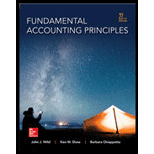
Concept explainers
Introduction:
• Process Costing is a method of cost allocation and calculation used when the types of goods produced are similar in nature and in large quantities.
• The cost allocation is done for all products on basis of a
• The advantage of this method is that it allows for simple and efficient cost allocation and calculation especially when the variations in the types of goods produced are minimal.
Cost Classification
• The time taken from the start of the sale process, i.e. the receipt of a confirmed sales order, to the completion of the transfer of goods or services, i.e. dispatch of goods consists of several activities and costs. Components of costs comprise of Variable costs,
• Variable costs refer to the costs of manufacture that have a direct co-relation with the volume of the goods manufactured, i.e. the costs increase with an increase in the goods produced. Examples are costs of direct material and direct labor.
• Manufacturing costs are costs that are directly incurred in connection with manufacture of goods. Examples are Direct materials and Manufacturing
• Fixed costs refer to the costs of manufacture that have an inverse co-relation with the volume of the goods manufactured, i.e. the costs decrease with an increase in the goods produced. Examples are costs of factory rent,
To Determine:
List of costs associated with one process of the U.S. Postal Office
Trending nowThis is a popular solution!

Chapter 20 Solutions
Fundamental Accounting Principles -Hardcover
- A trial balance includes:A. Only revenue and expense accountsB. All accounts with balancesC. Only permanent accountsD. Only assets and liabilitiesarrow_forwardThe matching principle helps ensure:A. Revenues are equal to expensesB. Revenues and related expenses are recorded in the same periodC. Cash is matched to liabilitiesD. Accounts match physical inventoryneed helparrow_forwardThe matching principle helps ensure:A. Revenues are equal to expensesB. Revenues and related expenses are recorded in the same periodC. Cash is matched to liabilitiesD. Accounts match physical inventoryarrow_forward
- No Ai A trial balance includes:A. Only revenue and expense accountsB. All accounts with balancesC. Only permanent accountsD. Only assets and liabilitiesarrow_forwardWhich account is increased with a credit?A. CashB. Salaries ExpenseC. Accounts ReceivableD. Service Revenue need helparrow_forwardNo AI A trial balance includes:A. Only revenue and expense accountsB. All accounts with balancesC. Only permanent accountsD. Only assets and liabilitiesarrow_forward
- I need help with this general accounting problem using proper accounting guidelinesarrow_forwardHello Needed Answer of Financial Accounting Question with Correct Methodarrow_forwardNo AI Which account is increased with a credit?A. CashB. Salaries ExpenseC. Accounts ReceivableD. Service Revenuearrow_forward

 AccountingAccountingISBN:9781337272094Author:WARREN, Carl S., Reeve, James M., Duchac, Jonathan E.Publisher:Cengage Learning,
AccountingAccountingISBN:9781337272094Author:WARREN, Carl S., Reeve, James M., Duchac, Jonathan E.Publisher:Cengage Learning, Accounting Information SystemsAccountingISBN:9781337619202Author:Hall, James A.Publisher:Cengage Learning,
Accounting Information SystemsAccountingISBN:9781337619202Author:Hall, James A.Publisher:Cengage Learning, Horngren's Cost Accounting: A Managerial Emphasis...AccountingISBN:9780134475585Author:Srikant M. Datar, Madhav V. RajanPublisher:PEARSON
Horngren's Cost Accounting: A Managerial Emphasis...AccountingISBN:9780134475585Author:Srikant M. Datar, Madhav V. RajanPublisher:PEARSON Intermediate AccountingAccountingISBN:9781259722660Author:J. David Spiceland, Mark W. Nelson, Wayne M ThomasPublisher:McGraw-Hill Education
Intermediate AccountingAccountingISBN:9781259722660Author:J. David Spiceland, Mark W. Nelson, Wayne M ThomasPublisher:McGraw-Hill Education Financial and Managerial AccountingAccountingISBN:9781259726705Author:John J Wild, Ken W. Shaw, Barbara Chiappetta Fundamental Accounting PrinciplesPublisher:McGraw-Hill Education
Financial and Managerial AccountingAccountingISBN:9781259726705Author:John J Wild, Ken W. Shaw, Barbara Chiappetta Fundamental Accounting PrinciplesPublisher:McGraw-Hill Education





